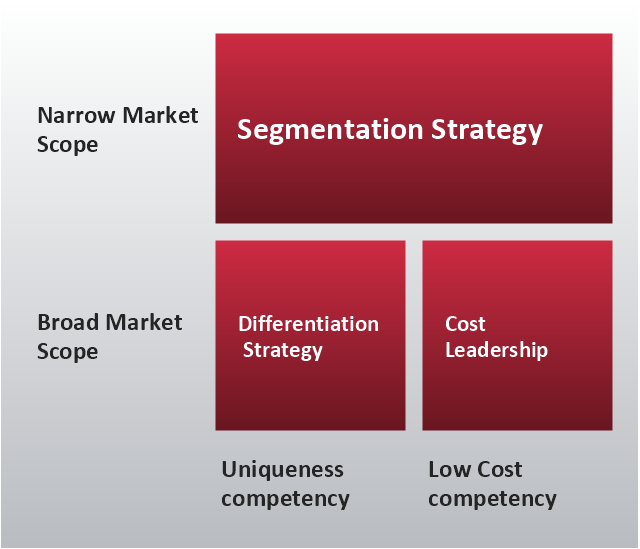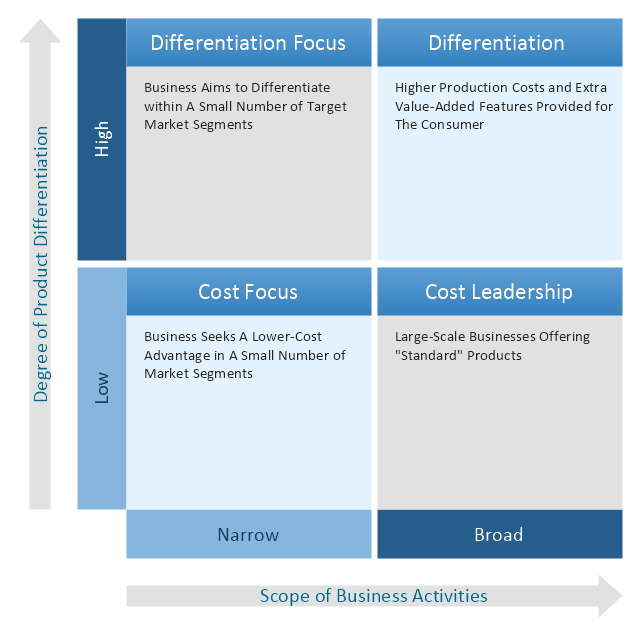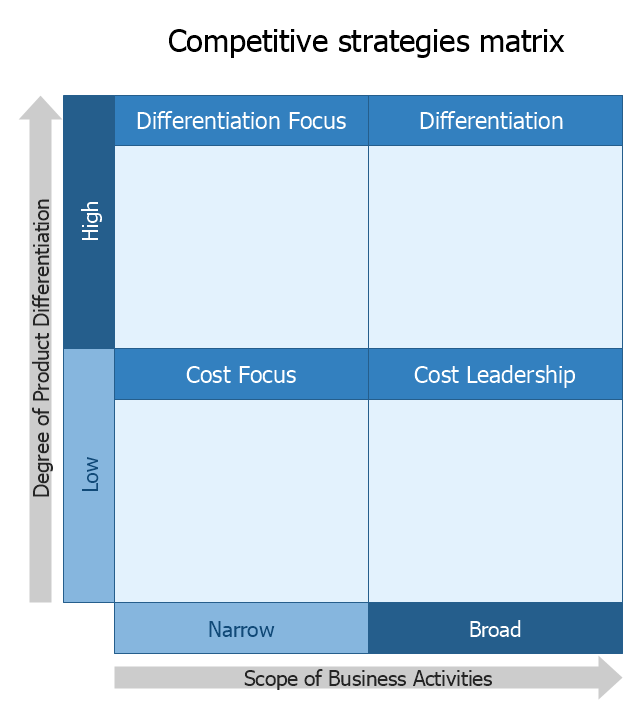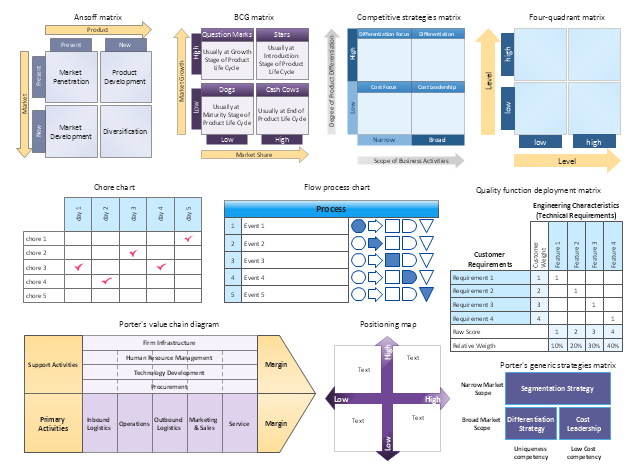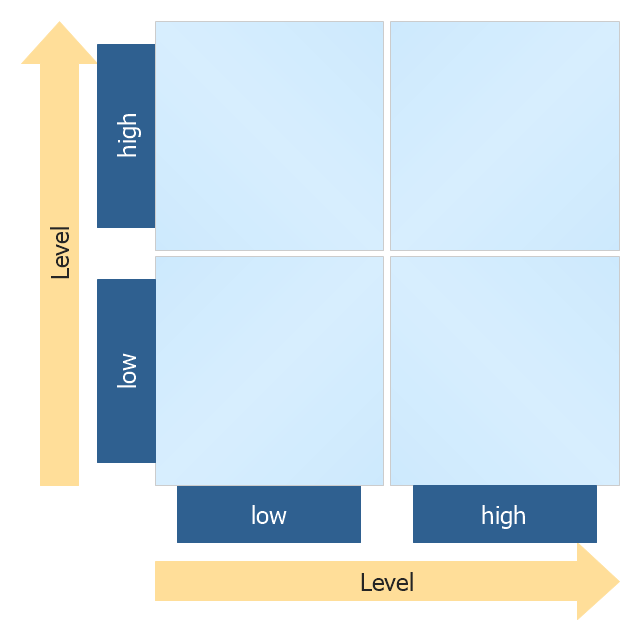"Michael Porter has described a category scheme consisting of three general types of strategies that are commonly used by businesses to achieve and maintain competitive advantage. These three generic strategies are defined along two dimensions: strategic scope and strategic strength. Strategic scope is a demand-side dimension and looks at the size and composition of the market you intend to target. Strategic strength is a supply-side dimension and looks at the strength or core competency of the firm. In particular he identified two competencies that he felt were most important: product differentiation and product cost (efficiency)." [Porter's generic strategies. Wikipedia]
This Porter's generic strategies matrix diagram was redesigned from Wikipedia file PorterGenericStrategies.png. [en.wikipedia.org/ wiki/ File:PorterGenericStrategies.png]
This file is licensed under the Creative Commons Attribution-Share Alike 3.0 Unported license.
[creativecommons.org/ licenses/ by-sa/ 3.0/ deed.en]
This Porter's generic strategies matrix diagram example was created by the ConceptDraw PRO diagramming and vector drawing software extended with the Matrices solution from the Marketing area of ConceptDraw Solution Park.
www.conceptdraw.com/ solution-park/ marketing-matrices
This Porter's generic strategies matrix diagram was redesigned from Wikipedia file PorterGenericStrategies.png. [en.wikipedia.org/ wiki/ File:PorterGenericStrategies.png]
This file is licensed under the Creative Commons Attribution-Share Alike 3.0 Unported license.
[creativecommons.org/ licenses/ by-sa/ 3.0/ deed.en]
This Porter's generic strategies matrix diagram example was created by the ConceptDraw PRO diagramming and vector drawing software extended with the Matrices solution from the Marketing area of ConceptDraw Solution Park.
www.conceptdraw.com/ solution-park/ marketing-matrices
"Michael Porter has described a category scheme consisting of three general types of strategies that are commonly used by businesses to achieve and maintain competitive advantage. These three generic strategies are defined along two dimensions: strategic scope and strategic strength. Strategic scope is a demand-side dimension and looks at the size and composition of the market you intend to target. Strategic strength is a supply-side dimension and looks at the strength or core competency of the firm. In particular he identified two competencies that he felt were most important: product differentiation and product cost (efficiency).
In his 1980 classic Competitive Strategy: Techniques for Analyzing Industries and Competitors, Porter simplifies the scheme by reducing it down to the three best strategies. They are cost leadership, differentiation, and market segmentation (or focus). Market segmentation is narrow in scope while both cost leadership and differentiation are relatively broad in market scope." [Porter's generic strategies. Wikipedia]
This competitive strategy matrix diagram example was created using the ConceptDraw PRO diagramming and vector drawing software extended with the Matrices solution from the Marketing area of ConceptDraw Solution Park.
www.conceptdraw.com/ solution-park/ marketing-matrices
In his 1980 classic Competitive Strategy: Techniques for Analyzing Industries and Competitors, Porter simplifies the scheme by reducing it down to the three best strategies. They are cost leadership, differentiation, and market segmentation (or focus). Market segmentation is narrow in scope while both cost leadership and differentiation are relatively broad in market scope." [Porter's generic strategies. Wikipedia]
This competitive strategy matrix diagram example was created using the ConceptDraw PRO diagramming and vector drawing software extended with the Matrices solution from the Marketing area of ConceptDraw Solution Park.
www.conceptdraw.com/ solution-park/ marketing-matrices
"Michael Porter has described a category scheme ... of ... general types of strategies ... defined along two dimensions: strategic scope and strategic strength. Strategic scope is a demand-side dimension and looks at the size and composition of the market you intend to target. Strategic strength is a supply-side dimension and looks at the strength or core competency of the firm. In particular he identified two competencies that he felt were most important: product differentiation and product cost (efficiency)." [Porter's generic strategies. Wikipedia]
This competitive strategy matrix template for the ConceptDraw PRO diagramming and vector drawing software is included in the Matrices solution from the Marketing area of ConceptDraw Solution Park.
www.conceptdraw.com/ solution-park/ marketing-matrices
This competitive strategy matrix template for the ConceptDraw PRO diagramming and vector drawing software is included in the Matrices solution from the Marketing area of ConceptDraw Solution Park.
www.conceptdraw.com/ solution-park/ marketing-matrices
The vector stencils library Matrices contains 10 templates of marketing matrices and tables: chore chart, flow process chart, quality function deployment (QFD) chart, Ansoff matrix, BCG matrix, competitive strategies matrix, four-quadrant matrix, positioning map, Porter's value chain diagram, Porter's generic strategies matrix.
Use these templates to add marketing matrices and tables to your business documents, websites, presentation slides and infographics.
The example "Design elements - Matrices" was created using the ConceptDraw PRO diagramming and vector drawing software extended with the Matrices solution from the Marketing area of ConceptDraw Solution Park.
www.conceptdraw.com/ solution-park/ marketing-matrices
Use these templates to add marketing matrices and tables to your business documents, websites, presentation slides and infographics.
The example "Design elements - Matrices" was created using the ConceptDraw PRO diagramming and vector drawing software extended with the Matrices solution from the Marketing area of ConceptDraw Solution Park.
www.conceptdraw.com/ solution-park/ marketing-matrices
"A matrix chart shows relationships between two or more variables in data set in a grid format. Essentially the matrix chart is a table made up of rows and columns that present data visually and can be seen as the visual equivalent of a crosstabulation that divides data between the variables. The matrix chart is formed through at least two variables, for the X- and Y-categories. If there is a third or fourth variable, color or other another dimension can be added to the matrix to represent it." [betterevaluation.org/ evaluation-options/ matrixchart]
The 4 quadrant matrices (2x2 matrices) are used in time management for personal goals prioritization.
"Time management strategies are often associated with the recommendation to set personal goals. ...
These goals are recorded and may be broken down into a project, an action plan, or a simple task list. For individual tasks or for goals, an importance rating may be established, deadlines may be set, and priorities assigned.
The Eisenhower Method
All tasks are evaluated using the criteria important/ unimportant and urgent/ not urgent and put in according quadrants. Tasks in unimportant/ not urgent quadrants are dropped, tasks in important/ urgent quadrants are done immediately and personally, tasks in unimportant/ urgent quadrants are delegated and tasks in important/ not urgent quadrants get an end date and are done personally. This method is said to have been used by U.S. President Dwight D. Eisenhower, and is outlined in a quote attributed to him: What is important is seldom urgent and what is urgent is seldom important." [Time management. Wikipedia]
This four quadrant matrix template for the ConceptDraw PRO diagramming and vector drawing software is included in the Matrices solution from the Marketing area of ConceptDraw Solution Park.
www.conceptdraw.com/ solution-park/ marketing-matrices
The 4 quadrant matrices (2x2 matrices) are used in time management for personal goals prioritization.
"Time management strategies are often associated with the recommendation to set personal goals. ...
These goals are recorded and may be broken down into a project, an action plan, or a simple task list. For individual tasks or for goals, an importance rating may be established, deadlines may be set, and priorities assigned.
The Eisenhower Method
All tasks are evaluated using the criteria important/ unimportant and urgent/ not urgent and put in according quadrants. Tasks in unimportant/ not urgent quadrants are dropped, tasks in important/ urgent quadrants are done immediately and personally, tasks in unimportant/ urgent quadrants are delegated and tasks in important/ not urgent quadrants get an end date and are done personally. This method is said to have been used by U.S. President Dwight D. Eisenhower, and is outlined in a quote attributed to him: What is important is seldom urgent and what is urgent is seldom important." [Time management. Wikipedia]
This four quadrant matrix template for the ConceptDraw PRO diagramming and vector drawing software is included in the Matrices solution from the Marketing area of ConceptDraw Solution Park.
www.conceptdraw.com/ solution-park/ marketing-matrices
- Porter's generic strategies matrix diagram | Competitive strategy ...
- Porter's value chain matrix diagram | Marketing | Porter's generic ...
- Porter's generic strategies matrix diagram | Competitive strategy ...
- Porter's generic strategies matrix diagram | SWOT Analysis Solution ...
- Porter's generic strategies matrix diagram | Matrices | Porter's value ...
- Porter's value chain matrix diagram | Porter's generic strategies ...
- Competitive strategy matrix template | - Conceptdraw.com
- Porter's generic strategies matrix diagram
- Matrices | Boston growth -share (BCG) matrix diagram | Porter's ...
- Competitive strategy matrix template
- SWOT analysis matrix - Template | Boston growth -share matrix ...
- SWOT Analysis Solution - Strategy Tools | Competitive strategy ...
- Four-quadrant matrix template | Competitive strategy matrix |
- Pyramid Chart Examples | Top brand model pyramid diagram ...
- Target and Circular Diagrams | Business diagrams & Org Charts ...
- Porter's value chain matrix diagram | Matrices | Marketing |
- Seven Management and Planning Tools | Matrices | SWOT analysis ...
- Ansoff's Product/Market matrix | Ansoff Product-Market Growth Matrix
- Competitive strategy matrix template | SWOT Analysis Solution ...
- Porter's value chain matrix diagram |
